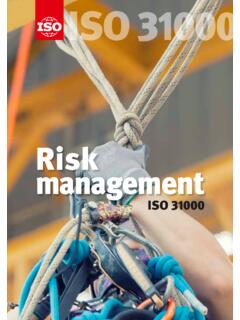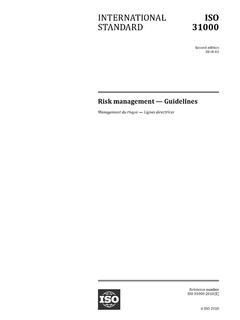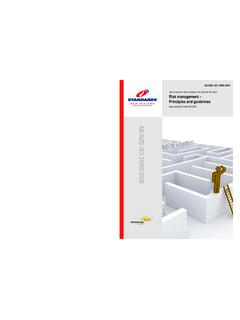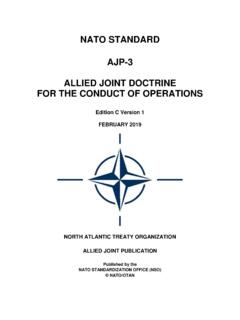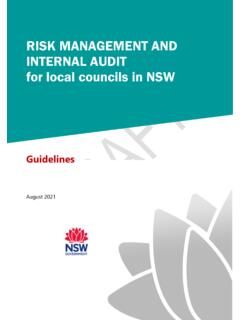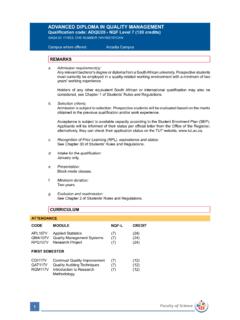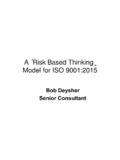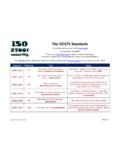Transcription of Operational Risk Appetite Statement Example
1 Visit for additional content, training and consulting related to Operational risk management . Operational Risk Appetite Statement Example Introduction Many financial services organizations are currently in the process of defining or revising their Operational risk Appetite framework. A key part of the framework is defining the risk Appetite Statement . Such statements are the main channel through which an organization can effectively communicate and instill risk management into their decision making process. Developed and utilized effectively they can support the business as a whole to make risk based decisions at all levels. Challenges The risk Appetite Statement typically covers confidential information about the organization and hence it is unlikely that any organization will publicly make its risk Appetite Statement available. Most organizations do not have prior experience of formally defining and documenting their Operational risk Appetite . Due to this a high level of uncertainty currently exists on what should be included in the risk Appetite Statement .
2 The above two factors combined together has created a gap within the Operational risk community on what are the best practices related to content covered within a risk Appetite Statement . Solution To address the above challenges, the RiskSpotlight team has performed in-depth research on risk Appetite focusing on the Operational risk element. The research has covered diverse sources such as The Financial Stability Board, ISO 31000 , COSO ERM & The Institute of Risk management . Based on the best practices identified from the researched sources, we have created an Operational risk Appetite Statement for a fictitious organization RWS Bank. This Statement contains all the key topics a financial services organization should consider covering within its own Operational risk Appetite Statement . Our intention by sharing this with the Operational risk community is to give a starting point for the Operational risk practitioners to have a structured discussion on this topic. While practitioners may be reluctant to share their own company specific content on the internal Appetite Statement , we expect that they would be more willing to provide their inputs on an Appetite Statement for a fictitious bank.
3 RiskSpotlight will publish this document on all the key risk management LinkedIn groups so practitioners can provide their feedback and inputs to further enrich this document. Based on the inputs received, we will periodically release new versions of this document, so it can become a standard template for the Operational risk community to use for defining and benchmarking their own internal Operational risk Appetite statements. The team at RiskSpotlight have expertise and experience in developing the frameworks, content and providing training on all the key elements that go into creating an effective Risk Appetite framework. We can offer training, content and consultancy in support of all of these areas and are going to be offering an online training course focused on Risk Appetite for Operational Risk. Page 1 Background to Operational Risk at RWS Bank Purpose: - This section provides high-level information related to the Operational risk framework utilized at RWS Bank, where such information is pertinent to the Operational risk Appetite Statement that follows.
4 Page 2 About RWS Bank RWS Bank is a medium-sized retail bank based in the east coast of US. It provides the following products and services: - Consumer Banking Residential Mortgage Commercial and Business Lending It currently serves one million retail consumers and 25,000 commercial organizations across 5 states. It serves the customers from its 200 branches and through its online channel. Here are some financial statistics for the most recent year: - Financial Item Figures Net Interest Income $681 Million Noninterest Income $290 Million Assets $27 Billion Loans $18 Billion Deposits $19 Billion Page 3 Operational Risk at RWS Bank RWS has adopted the following definition of Operational risk: - Potential events (including sets of circumstances), which may result in positive and/or negative impacts and where such impacts may influence one or more Operational objectives of the bank and where there is a level of uncertainty about one or more of the above aspects The above definition is based on the definition of risk covered within ISO 31000 , which is the international standard for risk management .
5 The bank recognizes that Operational risks : - Are inherent within its current business operations OR May emerge from new business decisions impacting the business operations OR May emerge from changes within the internal or external context of the bank Unlike other banks, RWS does not perceive Operational risks to be just potential events with negative impacts. RWS s business strategy is based on adopting and implementing innovative ideas and technologies within its products, services, customer interactions and business processes. The bank recognizes that to implement an innovation-driven business strategy, it will not only need to mitigate certain Operational risks but also increase its exposure to certain Operational risks . So unlike other banks, which adopt a completely defensive strategy for Operational risk management , RWS has adopted a combination of defensive and offensive strategies for Operational risk management . Page 4 RWS Operational risks are categorized across the following categories: - Business Process Execution Failures Damage to Tangible and Intangible Assets Employment Practices and Workplace Safety External Theft & Fraud Improper Business Practices Internal Theft & Fraud Regulatory & Compliance Technology Failures & Damages Vendor Failures & Damages The Group OpRisk Department has defined a library of 125 Operational risks based on the library provided by RiskSpotlight ( ) across the above categories.
6 These have been utilized as a starting point for risk registers for every business unit, who can add risks specific to their business context. For each Operational risk, the following data items are captured to fully understand the risk during risk identification and risk assessment: - Internal and/or External Causes that may increase or decrease the likelihood of the risk. For each cause, a source from where the cause could emerge is also captured One or more positive impacts that may result from the risk One or more negative impacts that may result from the risk One or more Operational objectives that may be influenced by the above impacts Page 5 Risk Assessment Criteria This section briefly covers the key aspects of Risk Assessment Criteria, which are relevant within the risk Appetite context. The complete documentation on Risk Assessment Criteria is not covered here. The bank has aligned the risk assessment criteria to the guidance provided within ISO 31000 , which is a widely adopted international standard on risk management .
7 For each Operational risk, one or more impacts are identified. In the Example below, Risk 101 has two impacts. Both impacts are negative impacts and this is represented with the red background color. In the Example below, Risk 102 has three impacts. Impacts 111 and 112 are negative impacts. Impact 113 is a positive impact and this is represented with the green background color. Page 6 For each impact, an assessment of Likelihood & Impact is performed. For negative impacts, the matrix below is used to derive the Impact Level for each impact. For positive impacts, the matrix below is used to derive the Impact Level for each impact. The Example below highlights the concepts discussed above for 2 risks . Page 7 Based on pre-defined aggregation criteria, the assessment of individual impacts is aggregated at the risk level. The negative impacts are aggregated as threats posed by the risk and the positive impacts are aggregated as opportunities presented by the risk.
8 The Example below highlights aggregation for two risks . Page 8 Risk Appetite Related Concepts The diagram below highlights the various concepts that RWS Bank has considered when defining their risk Appetite . Driving Concepts The three most important concepts which influence risk Appetite framework include: - Risk Culture Risk Capacity Strategy & Objectives Application Concepts The two key areas where risk Appetite is applied include: - Evaluating Risk Exposures Decision Making Implementation Concepts The three most common methods for implementing risk Appetite include: - Controls Policies Risk Tolerances Page 9 Operational Risk Appetite Statement for RWS Bank Version: Published Date: 27th August 2015 Information Classification: Confidential Page 10 Table of Contents INTRODUCTION .. 11 PURPOSE OF THE Operational RISK Appetite Statement .
9 12 RISK CRITERIA .. 13 RISK CRITERIA LEVELS .. 14 SUMMARY OF LEVELS & RELATED CRITERIA .. 21 LOSS THRESHOLDS .. 22 RISK Appetite BREACH REPORT .. 23 INCLUDING BUSINESS CONTEXT INFORMATION .. 24 EVALUATING THREATS AND OPPORTUNITIES .. 24 IMPLEMENTING RISK Appetite THROUGH RISK TOLERANCES .. 26 IMPLEMENTING RISK Appetite THROUGH POLICIES .. 26 IMPLEMENTING RISK Appetite THROUGH CONTROLS .. 27 ALIGNING RISK Appetite WITH RISK CAPACITY .. 28 CUSTOMIZE RISK Appetite Statement FOR BUSINESS UNITS .. 29 MONITORING RISK Appetite .. 30 RISK Appetite & RISK CULTURE .. 30 REVIEW OF RISK Appetite STATEMENTS .. 30 Page 11 Introduction The purpose of this document is to define and communicate key Operational risk Appetite related concepts and criteria, as covered within the Operational risk Appetite framework of the bank. The content of this document should provide clear guidance to the reader on which Operational risk exposures are acceptable and unacceptable to the bank.
10 Such clarity can facilitate risk-informed decision making across the bank on Operational risk related topics. This document has been reviewed and approved by the Board of the bank. The diagram below highlights the various concepts that have been considered when defining the risk Appetite of the bank: - Page 12 Purpose of the Operational Risk Appetite Statement The bank has identified that the risk Appetite Statement should be a valuable reference in the following scenarios: - When an individual or groups are making a significant business decision related to the business operations of the bank. Examples of such decisions may include outsourcing significant processes or IT systems, introducing new technology within products & expanding into new geographic locations. In such scenarios, the Statement should provide clear guidance on the bank s approach towards which Operational risks are acceptable and unacceptable. When an individual or groups are performing risk assessments and they need to identify whether the risk exposures are aligned with the bank s approach towards acceptable and unacceptable Operational risks .
